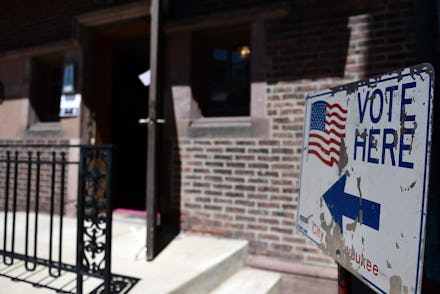Early voting lines are blocks long across the country. What's going on?

Welcome to Ballot Barriers, Mic's weekly voting column for the 2020 election. Each week we'll explore the challenge of voting in an election year that's unlike any other.
We’ve had four years to prepare for the most crucial presidential election in U.S. history. And yet, there are too few polling places available for voters to vote. The shortage has plagued both Republican-controlled states with a history of voter suppression and Democratic-run states. In New York City, where 190,000 people voted over the weekend, lines wrapped around blocks several times over. New York Rep. Alexandria Ocasio-Cortez (D) put it best: “Just because it’s happening in a blue state, doesn’t mean it’s not voter suppression.”
There are multiple reasons for the lack of polling places. They include sheer (and willful) denial about an election year that could see the highest voter turnout in over a century, polling place closures and consolidations due to COVID-19, and polling place closures due to the gutting of the Voting Rights Act in the 2013 Supreme Court decision Shelby County v. Holder. That ruling meant that states with a history of voter suppression no longer needed approval from the Department of Justice to make changes, such as polling location closures, to the election process; before Shelby, these states had to get federal “preclearance” or permission to do so. A newly released report by Vice found that since 2016, 21,000 polling places have closed across the United States. The lack of polling places has caused long lines for all voters, but especially Black and other voters of color.
We already saw this crisis in action during this year’s primary election. Take Milwaukee, a Democratic city that went for Hillary Clinton in 2016. (Wisconsin overall narrowly went for Trump.) The impact of poll closures was startling. In a report released earlier this year, researchers found that the closures reduced overall turnout by 8.5%, and reduced turnout by Black voters specifically by 10.2%. In Georgia, polling places closed or consolidated due to the pandemic. In the metro Atlanta area, the most populous area of the state with the highest number of nonwhite voters, there were 80 fewer polling locations. Even before coronavirus, the state had one of the highest number of polling place closures, and has closed some in locations where the number of registered voters has actually increased. Not coincidentally, Black eligible voters make up 32% of all eligible voters in the state.
At the end of the day, it makes no difference whether the lack of polling places is due to racist intentions, COVID-19, or poor planning. The outcome is the same: Too few polling places disenfranchise voters, and this disproportionately impacts Black, Indigenous, and other voters of color. Whether a state is red or blue doesn’t matter. A dearth of polling places in Philadelphia deprives voters of the right to vote just like a dearth of polling places in Miami or Houston.
What we will never know, and can never know, is the extent of this poll closure disenfranchisement. How many voters abandoned a long line because they had to return to work, or pick up a child from childcare? How many voters saw a long line, decided to put off voting for another day, but then never returned to the polls?
How many voters simply lack the ability to travel to a polling place far from their homes? In Georgia, a 2019 report from The Atlanta Journal-Constitution concluded that long distances to polling places prevented between 54,000 and 85,000 voters from casting their ballots in the 2018 midterm election. Additionally, “Black voters were 20% more likely to miss elections because of long distances,” the paper wrote. This year, some Georgia voters have to drive 25 miles to get to their nearest early voting location.
The election pandemonium caused by too few polling places is the fault of state and county governments. Elections in other countries run very smoothly. Elections in some U.S. states run relatively smoothly, too — Oregon, for example, which recently ranked as the easiest state for voting, offers automatic voter registration and all mail-in ballot voting. This is unimaginable to voters in other states, where mail-in ballots are only provided if a voter provides an accepted reason, and where polling places are consolidated or closed at the last minute.
This time around, this is our reality. And turnout organizations have worked doggedly to ensure that as many people as possible overcome the odds to vote. But it doesn’t have to be this way.
After the election, push for meaningful change. Attend your county and state board of election meetings; most are open to the public. Demand a better voting experience and access to convenient polling locations. If your concerns are not addressed, organize. In 2018, residents in Randolph County, Georgia, successfully rallied to stop the proposed closure of seven polling locations, which would have disproportionately affected Black voters. (Though three polling places were closed the following year, it was at least less than the initial seven.)
Take note of the issues you see in your community during this election, and pressure the people in power to make sure the next election is a better experience for everyone. Things may feel discouraging now, but they don’t always have to be.
Anjali Enjeti is a poll worker in Fulton County, Georgia, who has reported on voting and voter suppression for a number of publications. See last week's column here.